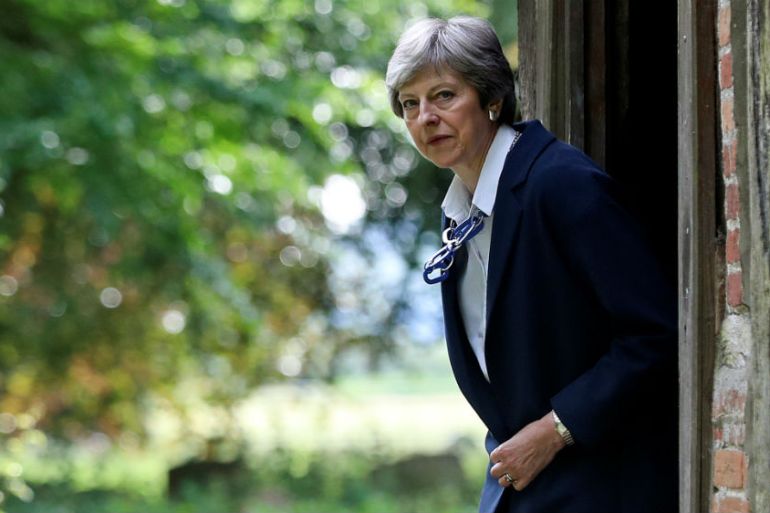Theresa May steps down amid chaos in British politics
Theresa May took charge of a divided nation after the 2016 Brexit referendum, and it remains divided as she steps down.

Theresa May has formally stepped down as leader of Britain’s governing Conservative Party, officially triggering a leadership contest that has effectively been running for several weeks.
The prime minister announced last month she would step down on Friday, June 7, after her authority to govern collapsed following three failed attempts to win parliament’s approval for a negotiated deal to leave the European Union.
Keep reading
list of 4 itemsControversial law sparks fist fight in Georgian parliament
‘Prejudice, Islamophobia’: Free speech fears as UK redefines extremism
Dominican FM on Haiti gang violence crisis: Spillover threat?
The final straw came when compromises offered to attract more support for the Brexit deal failed to sway opposition politicians and enraged members of her own party.
“Following notification from the Prime Minister, Rt Hon Theresa May MP, that she has resigned as leader of the Conservative and Unionist Party, the joint acting chairs of the 1922 Committee are inviting nominations from those Conservative Members of Parliament who wish to stand for election as the next party leader,” read a brief statement from the party’s backbench grouping.
The three-paragraph statement included no glowing tribute to her time in Downing Street, nor spoke of her achievements as prime minister.
“Nominations close at 5pm on Monday, June 10. The list of candidates, together with their proposer and seconder, will be made publicly available after the close of nominations.
“The Rt Hon Theresa May will remain as acting leader of the Conservative and Unionist Party until her successor has been announced,” it concluded.
Legacy?
May will keep the keys to Downing Street until her successor is elected when she will retire as prime minister and hand over the reins of power.
“For the remainder of her time in office, she will be building on the domestic agenda that she has put at the heart of her premiership,” her spokeswoman told reporters on Friday morning.
She is stepping down amid a growing dispute with Chancellor Philip Hammond over her plans to leave with a series of big spending announcements, including a multibillion-pound overhaul of England’s schools and colleges, according to the Financial Times.
Her team has been eager to shape her legacy beyond the Brexit failure, but she bequeaths to her successor a nation where traditional political identities are being eroded by strong beliefs on whether Britain should leave the EU, and how it should do so.
The contest to replace her has been heating up for weeks, with candidates arguing over the rights and wrongs of a “no-deal” Brexit, Britain’s most significant foreign and trade policy shift for more than 40 years.
Official nominations to replace her will be received on Monday, and Conservative Party grandees want the selection process to be completed by the end of July.
What’s next?
Her successor will face the same problems as May: Parliamentary arithmetic that does not give the governing party a majority in the House of Commons, a rapidly approaching Brexit deadline with EU officials ruling out any renegotiation of the exit deal, and a fatigued populace disillusioned with the process of Brexit and with the entire state of the British political class.
The selection process involves the 313 Conservative MPs whittling down the nominations to two. The 160,000 members of the party will then be invited to choose between the two in a postal ballot.
Whoever is selected will face pressure to call a general election in order to prove a democratic mandate to govern. But given the drubbing the party received both at last month’s European Parliament elections and this week’s Peterborough by-election, MPs will not be eager to face a wider electorate who appear to be abandoning mainstream parties in favour of those with more clearly defined positions on Brexit, which is taken in Britain to be the key political issue of our time.
Her low-key resignation saw May write to the joint acting chairmen of the backbench Conservative 1922 Committee, Charles Walker and Dame Cheryl Gillan, confirming the announcement she made two weeks ago outside the official residence of the prime minister.
She then spent her last day as Tory leader in her Maidenhead constituency, with the Peterborough by-election defeat a stark illustration of the difficulties she has faced and which will now trouble her successor.
As she leaves office, May leaves behind her a Britain riven with even more entrenched divisions than when she took over the nation’s helm in the wake of the 2016 Brexit referendum.
|
|